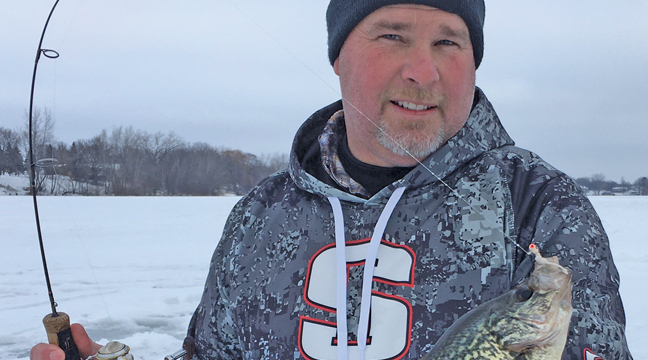Editor’s Note: Captain Josh Hagemeister has been making a living as a professional fishing guide for 31 years. He has worked at In-Fisherman Magazine’s Camp Fish as an instructional fishing guide for many years. He is married and has three boys who also love to hunt and fish.
It’s mid-winter now and for many anglers times are getting tough when it comes to finding and catching the same amounts of panfish they were just a month ago. But with a couple adjustments to make up for the change of fish location, success can be had through the month of February until the Spring transformation occurs.
Location, Location, Location. Probably the most common mistake I observe when it comes to the mid-winter fishing “blues” is that most anglers simply are afraid to change their fishing location. I observe the same “clusters” of people or fish houses in the same spots they were in during the month of December and/or January. Trust me, the fish are biting somewhere—just not where you are at if that’s the case. Pounding the same drilled up section of lake for weeks or months at a time does not work in the long haul! First of all—most of the fish are gone—caught and fried. Secondly, the fish that are left over are pressured fish and behave so. Meaning, they mark well on your electronics, come up to the bait and swim away most of the time. The only chance you have is to be there during the extremely tiny “feeding window” when they actually will commit to the bait. And that window gets smaller the more pressured they are. So in other words, don’t be lazy, look at the charts and G.P.S. you paid for and find some new areas and fish.
Finding new areas sounds easy—and it can be! Fish do not move great distances horizontally during the solid water period. Many of their movements, if any, are more vertical. So the good news is, if ya found a bunch of fish in a certain spot that you enjoyed catching but are now nowhere to be found—look a little further. Odds are the fish made some slight depth adjustment(s) based on the food source, oxygen levels, and the amount of pressure from above. They might have only moved 20 yards, or 50 yards, or 100 yards—either way they didn’t go too far from where they started. On many occasions, they simply slid a bit deeper on the same structural element. Now instead of being at 15 ft. they are at 25 ft. throughout the day. So be diligent on using your electronics through the ice to find the fish. Once you found what kind of depth or area they have moved to, try to mimic that in other areas of the lake. I personally try to have a minimum of 9-10 “good spots” on a body of water for each scenario. Good anglers always have options in their back pockets—if anything, when the masses discover your success, you can give them the slip and start over someplace different. Crowds are for concerts!
Once you found those tricky little buggers, you might have to adjust your presentation as well. Just because you caught fish on a tiny tungsten tipped with a plastic glow worm doesn’t mean it’s going to work now. Maybe you found the fish earlier in shallow weeds and sunfish or perch colors worked great, and now they are on the deep weed line edge or even suspended out from it over the mud. So now, red worm colors/browns/blacks make be a better choice. Odds are, the food sources in both of those locations are a little different. This is where an underwater camera can help out. What kind of plankton “spots” are you seeing? And how are they darting around? Maybe your jigging motion needs to change to match the movements of the plankton that is being spotted on the camera. Maybe they are chasing schools of minnows. If so, upsize the bait a bit. I realize that “go smaller” seems to be the norm when it comes to bait selection, but remember, these fish have been looking at “smaller” all winter. They are by the way closer to spawning than they were in December, and those eggs need food! On a side note, switching from tungsten to a classic lead bait of the same variety can be deadly.
It doesn’t take many adjustments to cash in on some great mid-winter fishing action. One thing is for sure, if no adjustments are made, fishing will be slow. So try ramping up your catch rates this winter by making some small adjustments, being proactive, thinking outside the box, and staying one step in front of the crowd.
Lotsa Fish! Lotsa Fun! Minnesota Fishing Guide Service, www.minnesotaguideservice.com www.minnesotaicefishhouserental.com Capt. Josh Hagemeister 320-291-0708, 218-732-9919









